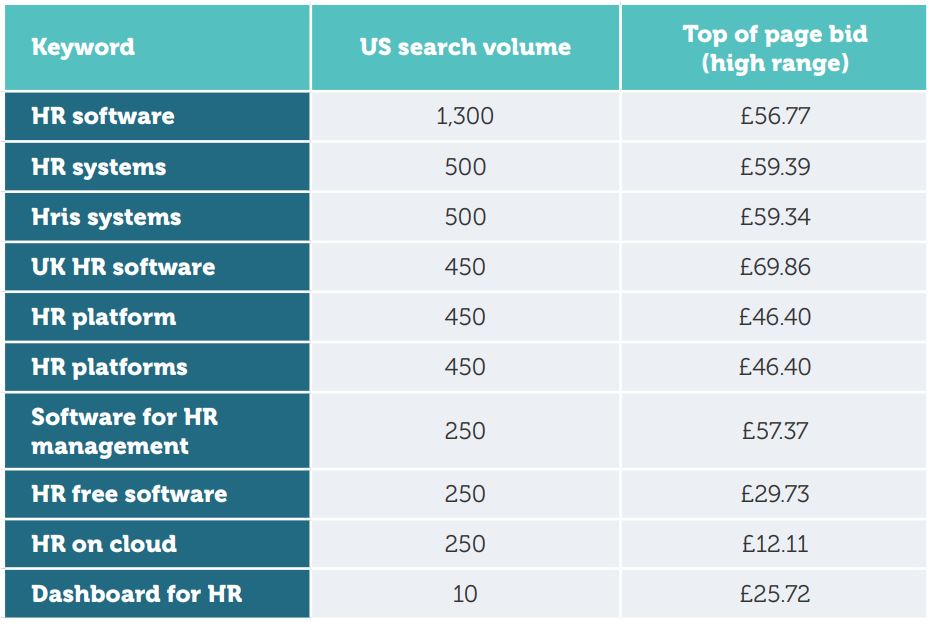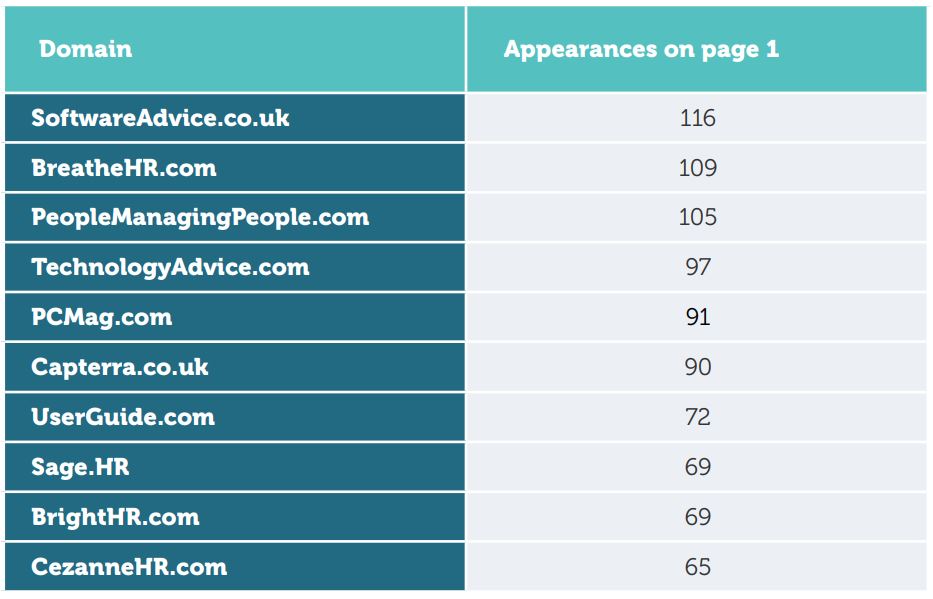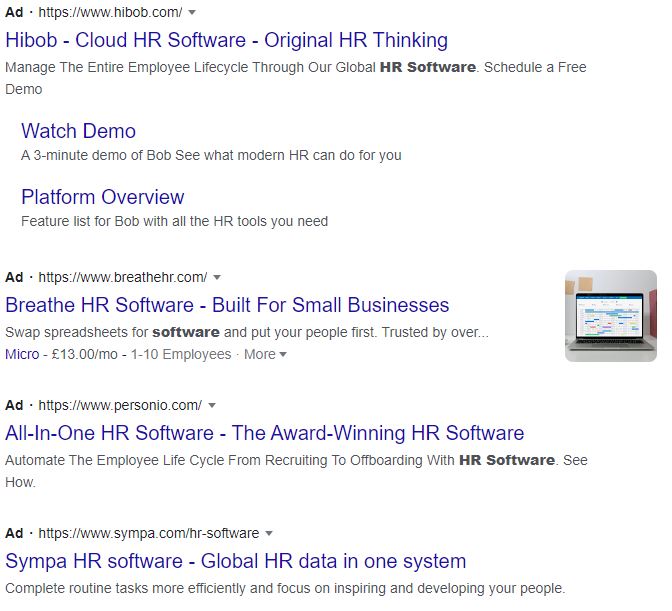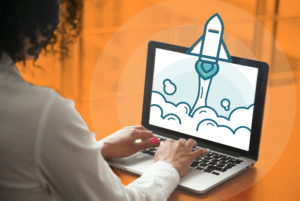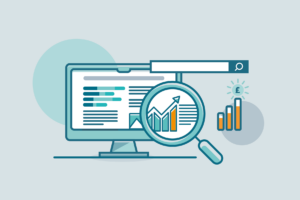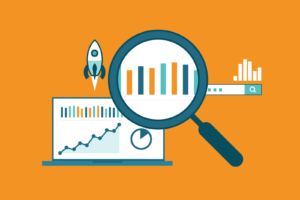Take More of the $24billion HR SaaS Market Without Hiring 50 Marketers

Three years after the outbreak of Covid-19, the way we think about work has changed forever. Following the shift to remote and hybrid working, companies had to quickly figure out how best to support a remote workforce, and this accelerating a shift to cloud based HR solutions, as demonstrated by ISG in their HR technology trends survey for 2021.
HR professionals and the C-suite are looking for HR SaaS solutions that can help them adapt to the new ways of working, whilst looking after employees and providing them with a frictionless experience when it comes to HR. The shift to remote and hybrid working has been welcomed by many people across industries, but it’s created challenges too. Around 20% of employees struggle with loneliness while working from home, while 67% say they feel less connected with colleagues.
The turmoil in the jobs market over the last few years that has boosted the search demand for HR software is significant, with the rapid development of AI tech starting to influence the recruitment process. Indeed, 92% of HR leaders are planning to increase use of AI as a solution for rising talent challenges.
However, very few providers are capitalising on this demand with an effective SEO and content strategy. Some are succeeding and taking a lion’s share of the traffic on offer, but still leaving money on the table for others to take.
Below, you can read our research into the HR SaaS market. Find out who’s winning and importantly, how you can claim more of the growing revenue on offer from an industry currently valued at $24billion and expected to reach over $35billion by 2030.
The tldr: who is winning, why, and how to beat them
Of the 25 firms that we researched, Gusto is winning in terms of the sheer volume of traffic that they are generating from organic search, particularly in the United States. They appear to be doing this via:
- A large marketing team of over 50 people, many more than competitors
- A relentless focus on producing content for their target audience
- Very strong brand awareness via broad, popular keyword rankings
- Excellent customer support content which also brings a lot of search traffic
- Genuinely useful, free online tools and calculators for their target audience to use
- Strong backing from a range of investors
How you can compete with them without hiring 50 marketers
Whilst hiring 50 marketers would help, it’s not something many of us are able to do overnight. Also, hiring lots of people will count for very little if you don’t have the right strategic approach in place. The good news is that you don’t have to do this in order to start grabbing hold of some of the opportunity to acquire more customers and grow your market share. You can do this by focusing and executing on a few key areas:
- Connect the key features of your HR software with the pain points of your ideal customers, then map these features to a robust content strategy, backed by SEO data and insights.
- Split your content strategy into targeting for customers who will use your software every day and customers who hold budget and influence over the decision making process.
- Create unique tools for your target customers which go beyond day-to-day HR issues and capitalise on our changing world, such as tools for team wellness and remote working.
- Connect your content strategy to marketing automation tools, utilising gated content for lead generation and nurturing for your sales team.
- Leverage a thought leadership approach, backed up by industry reports and data to establish your credibility and brand awareness on relevant publishers.
- Build relationships with key journalists and bloggers who write about HR software on a regular basis.
Or, just hire us and we’ll do all of this for you.
Now, let’s get into the details and show you why this is the right approach to grow your organic search traffic.
The organic search landscape
Using data from Ahrefs, we’re able to see who is the organic search market leader based on the volume of keywords that they rank for globally, combined with the estimated number of visitors they are getting from those keywords each month. Here is the top 10:
As we can see, Gusto is far and away the leader when it comes to the overall number of keywords that they are ranking for, plus the estimated amount of traffic that they are getting as a result. Let’s take a closer look at them and what they are getting right.
Gusto is generating most of their traffic from the US market which is one of the larger markets and it appears to be where they are most active. They also seem to have a large marketing team of over 50 people and they are producing a LOT of content via their blog and resource sections.
The marketing team is certainly doing a lot of things right when it comes to content. One example is their Resources section which includes things such as Business Planning calculators and Employer Tax calculators which HR professionals may use and bookmark. Placing your brand front of mind with HR professionals by providing something of value is a great way to build your brand via search and increase the likelihood of them becoming a future customer.
These tools and calculators appear to generate a decent amount of traffic whilst also attracting links to the domain with 405 linking domains to the /resources/ section alone. This means that they are not only attracting traffic, but they are also increasing the strength of their domain which in turn, will help attract more search traffic.
It’s also worth noting that they’re not the only ones enjoying success here. CharlieHR hasn’t scaled the idea as much as Gusto, but do have a holiday calculator and holiday pay calculator which ranks well and gets links. This approach seems to work well in this sector and whilst this can make it harder to stand out with such an approach, it is worth considering for a brand wanting to capitalise on what is working for others. With the current changing landscape, HR software firms need to be asking themselves how they can provide valuable tools that can help with hot topics such as remote working and employee wellness.
Gusto also has an extensive blog section which alone generates a huge chunk of their traffic and, given that they rank for over 200k keywords (far more than competitors) we can safely assume that they get a lot of long-tail traffic too.
Alongside these sections, they have a very detailed support subdomain that ranks for over 30k keywords on its own - this appears almost by accident because many keywords are similar to those they rank for on the blog.
Whilst they are doing a lot of things right, a byproduct of their success appears to be that they are generating a lot of traffic which may not be leading to potential customers. For example, some of their most popular keywords in terms of traffic generation are:
- [gross pay]
- [pay stub]
- [what is net pay]
These keywords are related to what Gusto provides but if we assume that their target market is business leaders and those who work in HR, these people are unlikely to be Googling these types of words.
Therefore, they are probably generating a lot of traffic which isn’t necessarily leading to conversions or customers. This isn’t to say that they are actively doing things wrong here, but when it comes to analysing their success, we need to bear in mind that a lot of their traffic may not be the traffic that you’d also like to target.
Aside from Gusto, we can see that BambooHR is second in our list of HR SaaS companies winning with their SEO strategy. BambooHR has closed the gap significantly on Gusto in the last few years, and now receives just ~14% less traffic than Gusto receives (still mostly US focused). Like Gusto, they are doing a good job with content production.
Their blog generates a lot of traffic and they have smartly created a glossary section that not only attracts traffic but also generates links. They seem to suffer from a similar problem to Gusto here in that the glossary will generate a lot of traffic but much of this traffic isn’t likely to be decision-makers in the HR or business leadership world.
Another area where BambooHR performs well is their webinars, which are run regularly and touch upon trending topics that are likely to appear to their target audience. They are also allowing previously run webinars to be accessed on-demand, and gating them to ensure they continue to generate leads. Many webinars are in partnership with related, non-competing companies which almost certainly gives each webinar more reach to a relevant audience.
Alongside webinars, BambooHR has a range of other gated content. Not only is this content generating leads, but some of these pages also rank well in organic search.
For example, thanks to its range of resources, BambooHR are ranking on page 1 in the US for the following keywords:
- [compensation trends 2022]
- [experience report]
- [rethink recruitment]
- [work from home expectation vs reality]
Whilst these keywords do not have lots of search volume, they are likely to be used by HR professionals who may become customers for BambooHR.
The organic keyword landscape
Whilst a relatively niche sector, keyword search volume in the UK and the US is pretty substantial. Our research showed that even if we just take the top ten most searched for keywords, the total number of searches per month is over 4,000 in the UK and nearly 12,000 in the US:
This is just for a small sample of ten keywords which shows the sheer size of the opportunity available to companies who are able to take advantage and get their SEO strategy and execution right.
The advantage of keywords like the ones above is that the intent behind them is very, very clear. Someone conducting a search for [HR software] is likely to be researching their options for trialling and onboarding HR software. Contrast this with the keywords we discussed earlier such as [gross pay] and [pay stub] that Gusto are ranking for and we can see a clear difference with intent.
The value of these keywords
We can understand more about the importance of targeting these keywords from an organic search perspective if we look at how much it would cost you per click to get traffic using Google Ads:
We can see that we could be paying up to £69 per click to get traffic for these high commercial intent keywords.
Here is how the picture looks for the top keywords in the US:
Here, you could be looking at paying up to $210 per click for these types of keywords.
Whilst paid media should be part of every brand’s digital marketing strategy, this shows the need to not be overly reliant on paid traffic and that organic search needs to share the load. Not to mention that as the market becomes more competitive, the costs for paid traffic are likely to increase every year. Indeed, the US CPC has increased by almost 300% in less than two years.
Who is winning with these keywords?
In terms of who is winning SEO if we focus on just keywords with a high level of commercial intent, this is how the list looks when we checked the rankings for over 200 keywords:
What you’ll notice here is that very few of the companies who are getting the most traffic overall, such as Gusto, perform as well when it comes to high commercial intent keywords. This presents an opportunity, but not the only opportunity. This data also reveals another element that needs to be part of your SEO strategy - publishers.
This list includes publishers who have written content on the topic of HR software—including these articles from PC Mag and Tech Radar—as well as comparison sites like SoftwareAdvice.co.uk, TechnologyAdvice.com and Capterra.co.uk.
This tells us that Google wants to show a mix of software providers and publishers on page 1, meaning that sometimes, users are looking for different types of results. In terms of SEO strategy, this opens up another avenue for us to grow our business. Not only should we try to rank directly for these types of high commercial intent keywords, but we should also build relationships with publishers who produce content related to our product.
The paid media landscape
So far we’ve looked at what HR SaaS companies are doing with organic search, but what about paid media? Organic traffic is great—after all, it’s “free”—but, as we touched on earlier, a lot of these companies are ranking for terms that might not be quite right in terms of search intent. An effective paid media strategy should get your brand and value proposition in front of the right people.
How much are HR SaaS leaders spending?
Gusto might be winning on the organic search battlefield, but the picture is different when we look at Google Ads—at least, they’re not competing as hard.
While Gusto were ahead on total HR software-related ranking keywords, and organic traffic, they’re a long way off the biggest Google Ads spenders in this space.
Let’s take a snapshot of this by looking at the activity around search terms related to ‘hr software’ in December 2022. The below table shows the five biggest US Google Ads spenders compared to Gusto.
Clearly, Gusto has a much smaller budget than the likes of IBM, Zoho and Sage, but they’ve clearly prioritised what to bid on. According to Semrush, Gusto was bidding on just six keywords in December 2022, but those keywords yielded an average of ~1,000 sessions each. By comparison, IBM’s keywords are yielding an average of just ~10 sessions each.
We were a bit surprised to see IBM appear at the top of the list for Google Ads spend. After all, the American corporation is known for hardware and IT software, not HR solutions.
The landing page IBM is sending people to is for IBM Watson Orchestrate, a ‘personal digital worker’ (which they’re also referring to as ‘digeys’) designed to provide HR, sales and operations professionals with their own interactive AI to help with mundane and mission-critical tasks. It’s not really a competitor to the other companies we’ve reviewed, but it’s interesting to note they’re spending on what appears to be very top of funnel keyword terms tangentially-related to the product.
Interestingly, of the 10 HR SaaS companies performing best for organic, only three appeared in our paid media report for December 2022 in the US (BambooHR, Culture Amp and 15five), while just two appeared in the UK report (Employment Hero and Culture Amp). Are the organic HR SaaS leaders choosing to rely on that organic traffic, rather than commit budget to Google Ads? Unless their organic traffic is converting at a high rate, this could be a missed opportunity.
What content is being promoted?
Let’s take a closer look at where this Google Ads traffic is actually being sent, as well as what content is being promoted on social media.
Google Ads
Below shows a selection of the advertisers bidding on the search term ‘hr software’ in the UK:
Unsurprisingly, given the intent of the search term, the ads here are directly promoting the software. As such, all four ads lead to landing pages detailing the specific features of the platforms, as well as offering software demos.
Gusto is also currently running ads on Facebook. From what we can see in Gusto’s Facebook Ads Library, all of these ads are bottom of the funnel:


It’s possible that these are remarketing ads only being shown to previous website visitors, but regardless, Gusto are potentially missing a bit of an opportunity here. Social media marketing is often at its best when brands provide valuable and engaging content to their target market, and exclusively running BoFu ads isn’t taking full advantage of this.
Like Gusto, BambooHR is running some BoFu ads, promoting the platform’s free trial. However, BambooHR is also running ads to gated content:

Although we’re unable to see the results of these ads, it’s important to include ToFu and MoFu content in the mix to avoid alienating a social media audience with sales messaging.
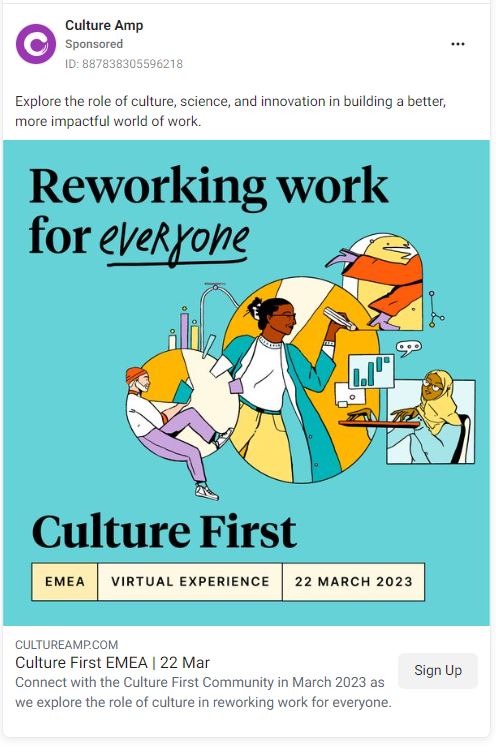
If your organisation is following in Gusto’s footsteps and simply pushing a sales message on Facebook, it might be time to consider promoting content that’s going to offer value too.
On LinkedIn at least, Gusto are mixing up its ads with some value-led content:

On the face of it, this seems to be a more holistic mix than what they’re offering on Facebook, but it’s important to note we’re making some assumptions based on what we know about best practice.
On the face of it, this seems to be a more holistic mix than what they’re offering on Facebook, but it’s important to note we’re making some assumptions based on what we know about best practice.
How to win if you’re a HR SaaS company
Let’s bring all of this together and look at what you need to do to acquire more customers via search and ultimately grow your market share.
At the moment, there is no one in the UK who is doing anywhere near the level of activity that we can see from Gusto. There is an opportunity for someone to use a similar approach, leveraging their own USPs and digital expertise to grow their share of organic search traffic.
The picture is a little different in North America, where the likes of Workday and Zenefits are putting a lot of effort into their content output, while the Germany-based Personio are doing the business in Europe, but there’s a big opportunity in UK market for a company to become the leader in the same way Gusto and others are doing. Here is how to do it without hiring 50 marketers like Gusto has.
Content strategy
You’re fortunate to be working in an industry that thrives on great content. HR professionals work with people and are often passionate about doing a great job, meaning that they are almost always looking for ways to learn and do a better job. The SaaS companies who are winning are ones who produce content that ties directly to:
- Customer pain points and problems
- Different buyer types within your target customer list, such as user buyers (those who use your software every day) and economic buyers (those who sign off budget and renewals). Hit those economic buyers with content that demonstrates the value of your software to their organisation.
- The customer journey from awareness of their need, right through to considering their options and finally, making a decision - you need content and landing pages across the entire journey
This should lead you to a core set of ideas and topics that you can produce, driving KPIs across your business:
- Organic search traffic
- Leads for your sales team
- Brand awareness
- Industry credibility and authority
There are other parts of the puzzle that will ensure more than just organic search traffic.
SEO strategy
Producing content is only the first step in a successful strategy. This content needs to be supported by SEO data, research and insights so that what you end up with is likely to rank well and bring the kind of results that your writing deserves. Every piece of content that you produce should be briefed by an experienced SEO who will advise on things such as:
- Which keywords to focus on and include in your content
- How to make use of structured data to help your content stand out in search results
- What internal links to your key features and related content should be included
- How to make the best use of headings and subheadings
- Guidelines on what ranks already and how to replicate what is working for them
This isn’t designed to get in the way of your creative writing and expertise—it’s designed to ensure that as many people as possible see your content and that your time doesn’t go to waste whilst your content disappears into the myriad of other content that is produced every day.
Lead generation and nurturing
Once you have visitors coming to your website, you need to ensure that you give yourself the best chance possible to convert them into customers. There are a number of ways to do this and one of the most scalable and efficient ways to do it is to use a CRM and Marketing Automation tool such as HubSpot which will allow you to:
- Drive visitors to leave their details by giving them something of value, such as advanced content, an eBook, a tool or a webinar.
- Customising the calls-to-action that a visitor sees based on where they have come from and what content they have viewed before.
- Scale and automate your email activity, sending relevant content and messages to your list whilst you’re working on something else (this is where you can act like a company with 50 marketers!)
- Track how many people visit your product pages after landing on a piece of content.
This, combined with a solid SEO strategy, will ensure that your content strategy adds real value to your business and moves far beyond “blogging”.
Promotion strategy
Finally, the missing piece of this is the requirement to tell the world about what you’re doing and build relationships with industry contacts who will be able to help you. This can take many forms, with the most effective methods for a HR SaaS company being:
- Find the publishers who regularly write about and review HR software (we’ve found a bunch for you already above) and start to build relationships with their writers.
- Take hero content pieces and promote them to industry publications and start to establish yourselves as a source of industry data and insights.
- Have an “always-on” approach to digital PR and watch for opportunities to comment on mainstream and industry news related to people and the workplace.
The combination of these approaches will help you achieve growth within your target market, whilst scaling your marketing without the need for huge headcounts by hitting the sweet spot between focusing on growth opportunities and automation.




